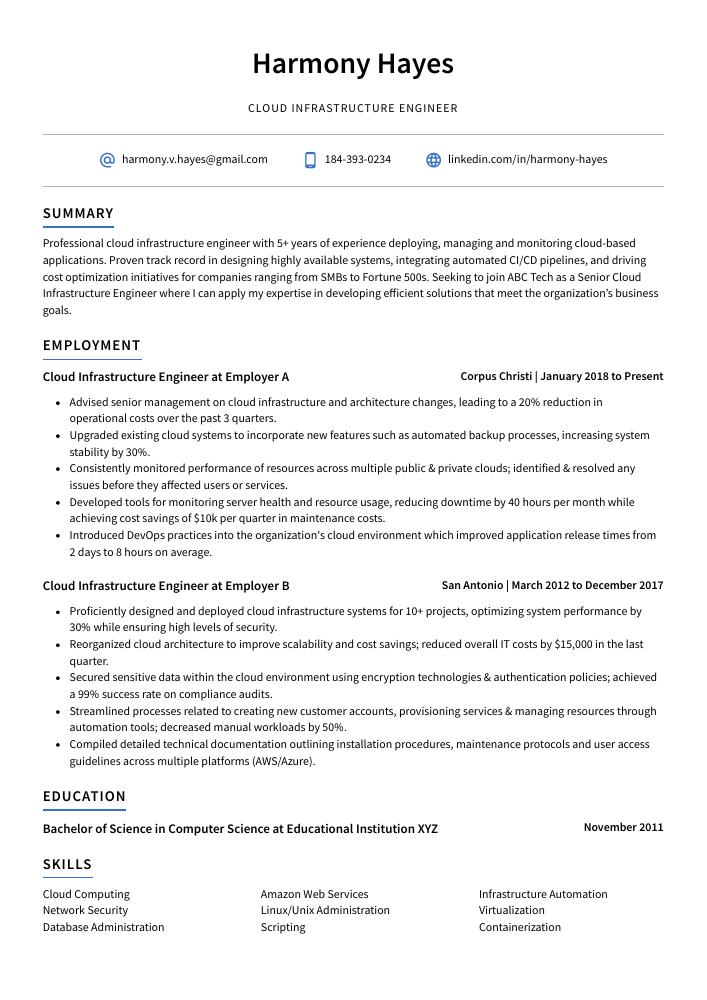Cloud Infrastructure Engineer Resume Guide
Cloud Infrastructure Engineers design, build, and maintain cloud-based systems for organizations. They are responsible for ensuring the reliability and scalability of services through monitoring performance metrics such as uptime, latency, throughputs, and storage utilization. Additionally they help to implement security measures in order to protect data from unauthorized access.
You have a knack for cloud infrastructure engineering, but hiring managers don’t know about it. To prove your worth to them and make sure they take notice of you, you must write an eye-catching resume that highlights all your technical abilities.
This guide will walk you through the entire process of creating a top-notch resume. We first show you a complete example and then break down what each resume section should look like.
Table of Contents
The guide is divided into sections for your convenience. You can read it from beginning to end or use the table of contents below to jump to a specific part.
Cloud Infrastructure Engineer Resume Sample
Harmony Hayes
Cloud Infrastructure Engineer
[email protected]
184-393-0234
linkedin.com/in/harmony-hayes
Summary
Professional cloud infrastructure engineer with 5+ years of experience deploying, managing and monitoring cloud-based applications. Proven track record in designing highly available systems, integrating automated CI/CD pipelines, and driving cost optimization initiatives for companies ranging from SMBs to Fortune 500s. Seeking to join ABC Tech as a Senior Cloud Infrastructure Engineer where I can apply my expertise in developing efficient solutions that meet the organization’s business goals.
Experience
Cloud Infrastructure Engineer, Employer A
Corpus Christi, Jan 2018 – Present
- Advised senior management on cloud infrastructure and architecture changes, leading to a 20% reduction in operational costs over the past 3 quarters.
- Upgraded existing cloud systems to incorporate new features such as automated backup processes, increasing system stability by 30%.
- Consistently monitored performance of resources across multiple public & private clouds; identified & resolved any issues before they affected users or services.
- Developed tools for monitoring server health and resource usage, reducing downtime by 40 hours per month while achieving cost savings of $10k per quarter in maintenance costs.
- Introduced DevOps practices into the organization’s cloud environment which improved application release times from 2 days to 8 hours on average.
Cloud Infrastructure Engineer, Employer B
San Antonio, Mar 2012 – Dec 2017
- Proficiently designed and deployed cloud infrastructure systems for 10+ projects, optimizing system performance by 30% while ensuring high levels of security.
- Reorganized cloud architecture to improve scalability and cost savings; reduced overall IT costs by $15,000 in the last quarter.
- Secured sensitive data within the cloud environment using encryption technologies & authentication policies; achieved a 99% success rate on compliance audits.
- Streamlined processes related to creating new customer accounts, provisioning services & managing resources through automation tools; decreased manual workloads by 50%.
- Compiled detailed technical documentation outlining installation procedures, maintenance protocols and user access guidelines across multiple platforms (AWS/Azure).
Skills
- Cloud Computing
- Amazon Web Services
- Infrastructure Automation
- Network Security
- Linux/Unix Administration
- Virtualization
- Database Administration
- Scripting
- Containerization
Education
Bachelor of Science in Computer Science
Educational Institution XYZ
Nov 2011
Certifications
AWS Certified Solutions Architect – Associate
Amazon Web Services
May 2017
1. Summary / Objective
The summary/objective at the top of your resume is like a trailer – it gives the employer an overview of who you are and why you excel as a cloud infrastructure engineer. Here is where you can showcase your best qualities. For example, you could talk about the number of years experience in developing cloud solutions, the certifications that demonstrate your expertise in this field, and how you have successfully implemented complex projects with minimal downtime.
Below are some resume summary examples:
Driven cloud infrastructure engineer with 10+ years of experience in designing, building, and operating cloud-based solutions. Proven track record of developing cost-effective yet secure architectures to meet customer needs. Skilled at managing DevOps processes such as continuous integration/continuous delivery pipelines and automation frameworks for large enterprises. Possess expertise in various cloud platforms including AWS, Azure and Google Cloud Platform.
Committed cloud infrastructure engineer with 4+ years of experience in designing, implementing, and managing secure cloud-based systems. Skilled at working across the AWS stack to build robust solutions for both cost optimization and scalability purposes. At XYZ, designed a multi-region architecture which reduced costs by 10% while increasing availability from 99% to 99.95%. Received company “Innovator” award for contribution to engineering team initiatives.
Dependable cloud infrastructure engineer with 8+ years of experience designing, deploying and managing cloud-based solutions in AWS. Proven track record in optimizing platform performance, enhancing security protocols and improving scalability metrics within demanding deadlines. Seeking to leverage technical expertise at ABC Tech to develop secure and reliable cloud infrastructures for the organization’s global clients.
Hard-working cloud infrastructure engineer with 8+ years of experience designing, deploying and managing cloud-based systems. Skilled in leveraging AWS services to optimize the reliability, scalability, security and performance of complex applications. Seeking to join ABC Tech to architect innovative solutions for their diverse customer base using my expertise in automation deployment tools like Ansible and Terraform.
Passionate cloud infrastructure engineer with 5+ years of experience in designing and managing cloud-based solutions. Skilled at developing cost-effective, high-performance systems while ensuring security compliance. Created a new cloud system for XYZ that reduced operational costs by 25%. At ABC developed an automated system to deploy and maintain servers on AWS resulting in improved scalability and performance.
Energetic cloud infrastructure engineer with 5+ years of experience in deploying and managing cloud-based solutions. Proven track record of building cost-effective, secure, highly available and scalable systems for clients. Skilled at working with AWS services such as EC2, S3, Lambda and CloudFormation to automate processes. Experienced in monitoring performance metrics using ELK Stack & New Relic APM tools.
Amicable and knowledgeable cloud infrastructure engineer with 7+ years of experience designing, deploying and managing large-scale distributed systems using Amazon Web Services (AWS). At XYZ, reduced costs by 30% by optimizing the AWS environment. Looking to join ABC Tech to help build robust and cost-effective solutions that meet customer demands while maintaining high levels of security.
Determined cloud infrastructure engineer with 4+ years of experience developing and maintaining cloud-based systems on AWS. Seeking to join ABC Tech to utilize my knowledge in automation, scripting, and DevOps practices for the improvement of their current cloud architecture. In previous roles, improved system uptime by 15% while reducing costs by 11%.
2. Experience / Employment
Next comes the work history section, which should be written in reverse chronological order. This means your most recent job is listed first and the rest follow in descending order.
When writing about what you did, use bullet points to make it easier for the reader to digest the information quickly. You want to provide detail on what you did and any quantifiable results that were obtained as a result of your efforts.
For example, instead of saying “Deployed cloud-based applications,” you could say, “Successfully deployed 5+ cloud-based applications using AWS EC2 instances with an average availability rate of 99% over a 12 month period.”
To write effective bullet points, begin with a strong verb or adverb. Industry specific verbs to use are:
- Configured
- Automated
- Monitored
- Optimized
- Implemented
- Secured
- Troubleshot
- Developed
- Deployed
- Refactored
- Tested
- Debugged
- Managed
- Upgraded
- Analyzed
Other general verbs you can use are:
- Achieved
- Advised
- Assessed
- Compiled
- Coordinated
- Demonstrated
- Expedited
- Facilitated
- Formulated
- Improved
- Introduced
- Mentored
- Participated
- Prepared
- Presented
- Reduced
- Reorganized
- Represented
- Revised
- Spearheaded
- Streamlined
- Structured
- Utilized
Below are some example bullet points:
- Expedited the deployment of cloud infrastructure projects by 35%, significantly reducing costs and increasing efficiency.
- Formulated and implemented best practices for the management of virtualized networks, servers, storage resources, databases and applications in a multi-cloud environment.
- Thoroughly tested system performance to ensure high availability/resiliency was maintained; identified & resolved technical issues before they became major problems, resulting in 99% uptime over the last 12 months.
- Presented findings from monthly audits to senior executives on areas such as security compliance, cost optimization opportunities & service delivery standards; consistently met or exceeded SLAs established with clients every quarter since taking on this role 3 years ago.
- Monitored AWS IAM roles & policies regularly to secure customer data while optimizing speed & scalability of services; increased application throughput by 25%.
- Revised and updated the cloud infrastructure architecture of a large-scale enterprise, resulting in an increase of 25% throughput and 90% reduction in latency.
- Prepared detailed flow diagrams and technical documentation outlining the processes for implementing secure cloud solutions; provided training to junior engineers on best practices related to configuring virtual machines (VMs).
- Resourcefully designed over 10 cost-effective strategies that optimized utilization of resources within AWS, Azure & GCP ecosystems while ensuring compliance with company security protocols; saved $50K+ annually on IT costs by right sizing VMs as needed.
- Improved system availability by 95%, increased uptime guarantee from 30 minutes to 2 hours via automated monitoring systems such as Nagios/Icinga/Ganglia etc., troubleshooting hardware or software issues remotely when required.
- Configured & administered various cloud tools including Puppet/Chef, Docker containers, Kubernetes clusters along with scripting languages like Python & Bash for automating routine tasks; reduced manual intervention time by 80%.
- Optimized cloud infrastructure of 10+ applications, increasing system performance by 40% and reducing operational costs by $4,000.
- Participated in the design, implementation & optimization of cloud-hosted services using AWS & Azure platforms; improved scalability and security across all systems.
- Reduced server outages from 20 incidences per month to just 5 through proactive monitoring that identified potential issues before they arose.
- Meticulously monitored network bandwidth usage for 100+ clients on a daily basis to ensure availability met service level agreements (SLAs).
- Demonstrated advanced knowledge in configuring networking protocols such as DHCP, SSH and DNS for client servers operating on various virtual private networks (VPNs).
- Utilized automation and scripting to maintain cloud-based infrastructure, reducing manual labor costs by 25%.
- Facilitated the implementation of security patches on server systems in two AWS regions within 24 hours; increased overall system performance & reliability by 15%.
- Spearheaded the successful migration of legacy applications from an on-premise data center to a multi-region AWS environment with no downtime for users.
- Diligently monitored network traffic and alert logs, troubleshooting any anomalies or errors as soon as they were detected throughout all services running in production environments.
- Represented IT team at customer meetings, providing technical assistance when needed and ensuring that projects ran smoothly according to schedule & budget constraints.
- Refactored cloud architecture for 3 enterprise-level clients, resulting in a 40% reduction of IT costs and an increase of scalability by 50%.
- Deployed 10+ cloud solutions to multiple locations across the world, utilizing various technologies such as Amazon Web Services (AWS), Azure and Google Cloud Platform (GCP).
- Actively monitored over 400 virtual servers running on AWS using advanced tools like New Relic and Datadog; promptly resolved any system issues while proactively suggesting performance improvements.
- Coordinated with DevOps teams to develop automated systems that provisioned highly available services on both public & private clouds within 8 hours or less per project requirement.
- Debugged complex problems related to network configurations, hardware/software compatibility issues and software bugs; resolving all queries quickly with minimal downtime or disruption of service delivery standards.
- Implemented cloud-based infrastructure solutions to improve scalability, security and performance for 10+ customers, resulting in a 25% reduction in system downtime.
- Structured cloud deployments across multiple platforms including AWS, Azure and Google Cloud Platform; reduced costs by 15%.
- Effectively monitored the health of all cloud resources using automated tools such as Nagios & Prometheus; identified and resolved any issue within minutes before it became an outage situation.
- Achieved rapid deployment times with Infrastructure-as-Code (IaC) practices like Terraform & Ansible while ensuring that best practice standards were adhered to at every step of the project life cycle.
- Troubleshot complex technical issues related to networking, storage systems, databases and applications running on various cloud environments; successfully restored service within 2 hours on average per incident resolution process initiated.
- Reliably managed and configured cloud infrastructure for over 150 clients, ensuring that data was securely stored in the cloud with no downtime or security breaches; reduced customer service complaints due to technical issues by 20%.
- Mentored junior engineers on best practices for designing, building and maintaining complex cloud architectures; improved team productivity by 10% within 6 months of leading the training program.
- Assessed current system performance metrics such as latency, availability & scalability levels and identified potential areas of improvement; implemented changes which resulted in a 25% increase in overall response time across all applications.
- Managed multiple projects simultaneously while adhering to tight deadlines without compromising quality standards; achieved 97% successful delivery rate on all projects completed within budgeted timelines.
- Analyzed log files to identify anomalies related to application performance or errors during deployment processes and developed automated scripts for continuous monitoring activities resulting in an 80% reduction of manual efforts spent troubleshooting problems every month.
3. Skills
Skill requirements will differ from employer to employer – this can easily be determined via the job advert. Organization ABC may require knowledge of Amazon Web Services, while organization XYZ may be looking for someone with experience in Google Cloud Platform.
Given this variability, it is important to tailor the skills section of your resume to each job you are applying for. This will help ensure that applicant tracking systems (which scan resumes for certain keywords) recognize your qualifications as a strong match and pass them on to a human recruiter.
In addition to listing relevant skills here, you should also discuss them further in other sections such as the summary or experience section.
Below is a list of common skills & terms:
- Amazon Web Services
- Cloud Computing
- Containerization
- Database Administration
- Infrastructure Automation
- Linux/Unix Administration
- Monitoring and Logging
- Network Security
- Scripting
- Virtualization
4. Education
Mentioning an education section on your resume will depend on how far along you are in your career. If you just graduated and have no professional experience, including an education section below the resume objective is a great way to showcase what you learned while studying cloud infrastructure engineering. On the other hand, if you already have significant work experience with plenty of responsibilities to include, omitting the education section might be best.
If an education section is included, try to list courses and subjects that relate directly or indirectly to cloud infrastructure engineering such as computer science fundamentals or distributed systems design.
Bachelor of Science in Computer Science
Educational Institution XYZ
Nov 2011
5. Certifications
Certifications demonstrate to potential employers that you have been tested and are proficient in a particular field. Having certifications on your resume will show hiring managers that you have taken the initiative to stay up-to-date with industry knowledge, as well as having gone through rigorous testing by an accredited organization.
Including any relevant certifications can be beneficial when applying for jobs, so make sure they are clearly listed near the top of your resume if applicable.
AWS Certified Solutions Architect – Associate
Amazon Web Services
May 2017
6. Contact Info
Your name should be the first thing a reader sees when viewing your resume, so ensure its positioning is prominent. Your phone number should be written in the most commonly used format in your country/city/state, and your email address should be professional.
You can also choose to include a link to your LinkedIn profile, personal website, or other online platforms relevant to your industry.
Finally, name your resume file appropriately to help hiring managers; for Harmony Hayes, this would be Harmony-Hayes-resume.pdf or Harmony-Hayes-resume.docx.
7. Cover Letter
Including a cover letter with your job application is a great way to tell a hiring manager more about yourself and stand out from other candidates. It’s usually made up of 2 to 4 paragraphs and contains information that isn’t already listed on your resume, such as why you’re particularly suited for the role or what skills you can bring to the company.
Cover letters aren’t always necessary but they are highly recommended when applying for jobs – recruiters often use them as an indication of how committed someone is to their profession and whether they’ll be able to make an impact in their new role.
Below is an example cover letter:
Dear Kennedi,
I am excited to apply for the Cloud Infrastructure Engineer position at Amazon. As a cloud infrastructure engineer with 5+ years of experience, I have the skills and knowledge to contribute to your organization. I am confident I can help you build and maintain a secure, scalable, and reliable cloud infrastructure.
In my previous role at Google, I was responsible for designing, implementing, and maintaining the company’s cloud infrastructure. I have experience with all major public clouds (AWS, Azure, GCP) and private clouds (OpenStack). I have also created multiple automation tools to improve efficiency and reduce costs.
I am knowledgeable about best practices for security in the cloud. I have implemented several security controls such as identity and access management, data encryption, firewalls, etc. My goal is always to protect customer data while ensuring compliance with regulations such as HIPAA and GDPR.
I believe my skills and experience will be a valuable asset to your team. I look forward to speaking with you about this opportunity in more detail soon. Thank you for your time!
Sincerely,
Harmony
Cloud Infrastructure Engineer Resume Templates
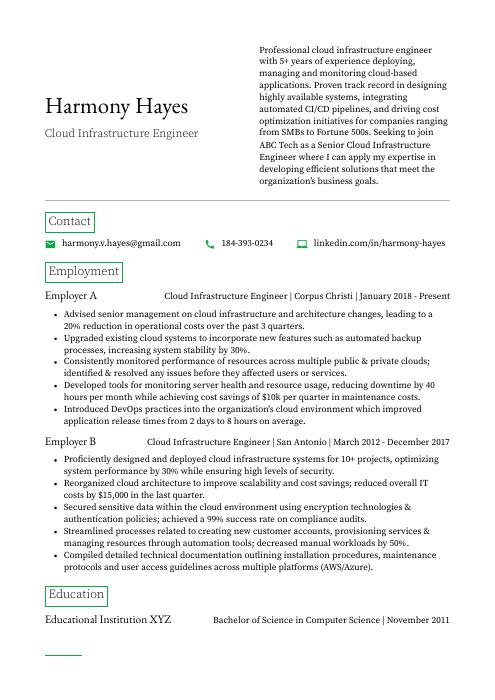 Quokka
Quokka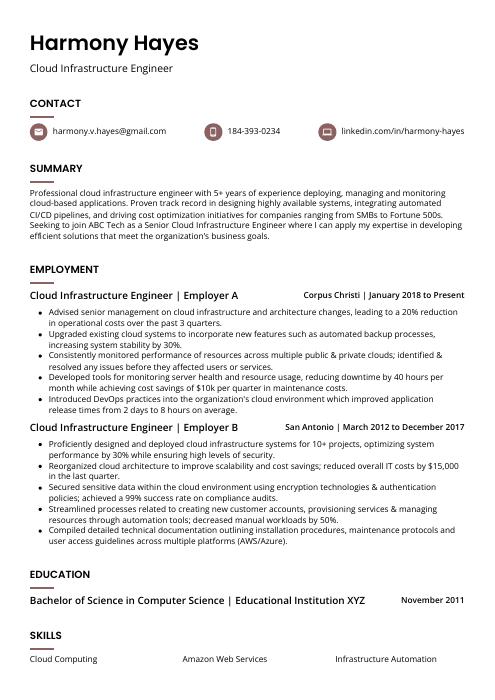 Fossa
Fossa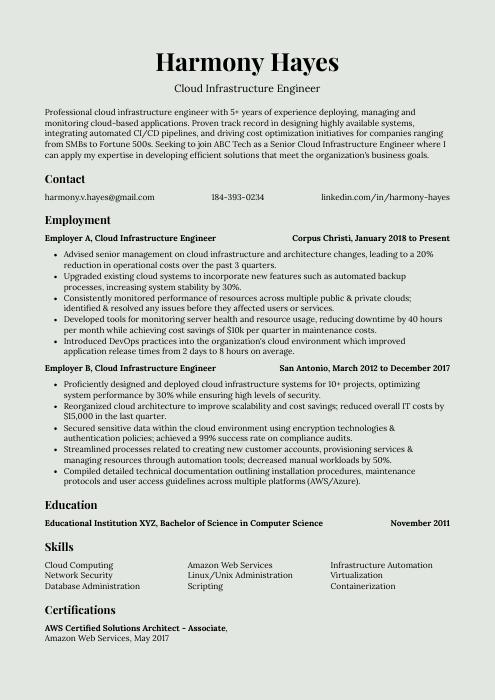 Saola
Saola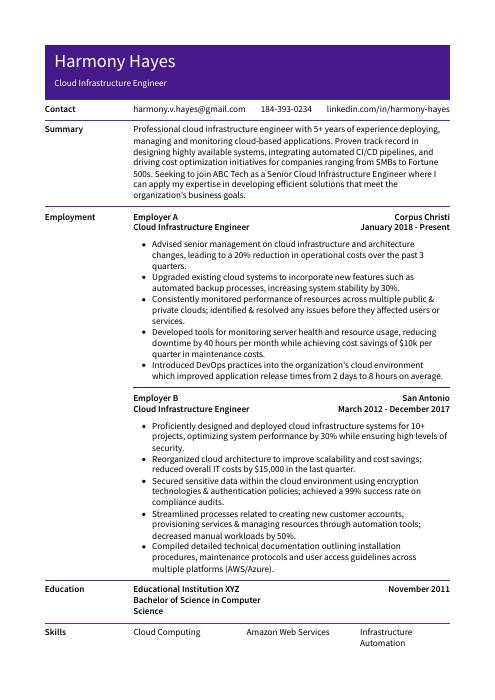 Pika
Pika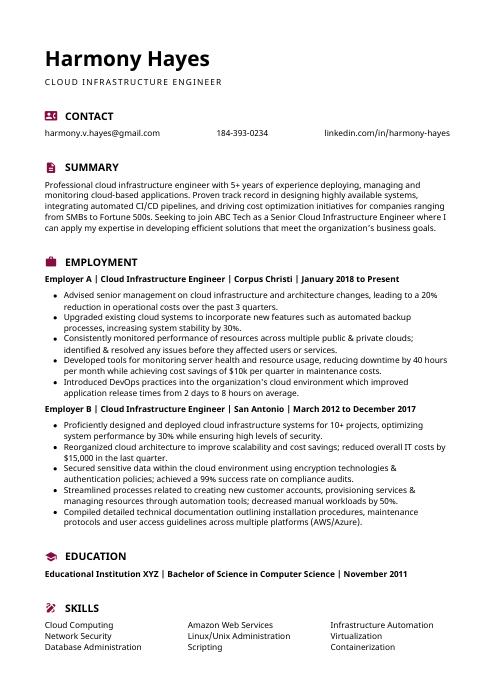 Hoopoe
Hoopoe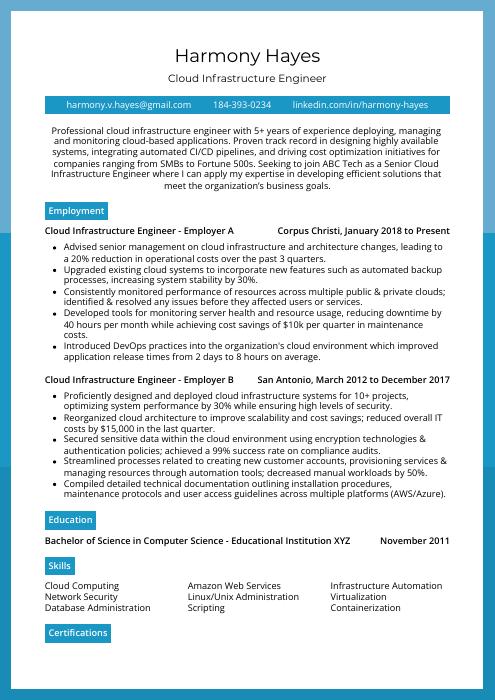 Rhea
Rhea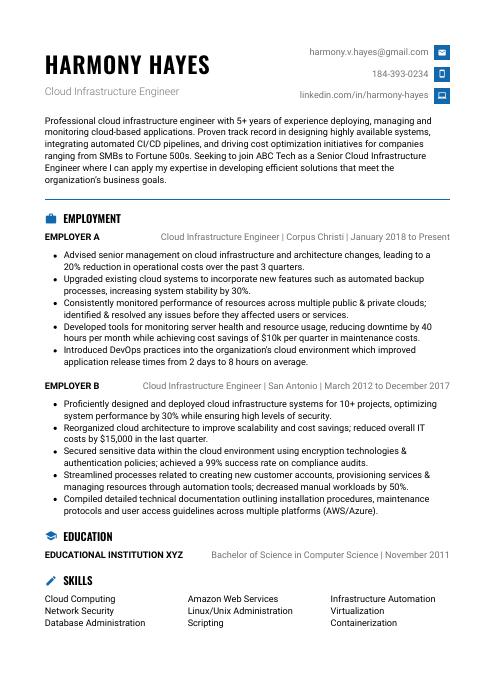 Echidna
Echidna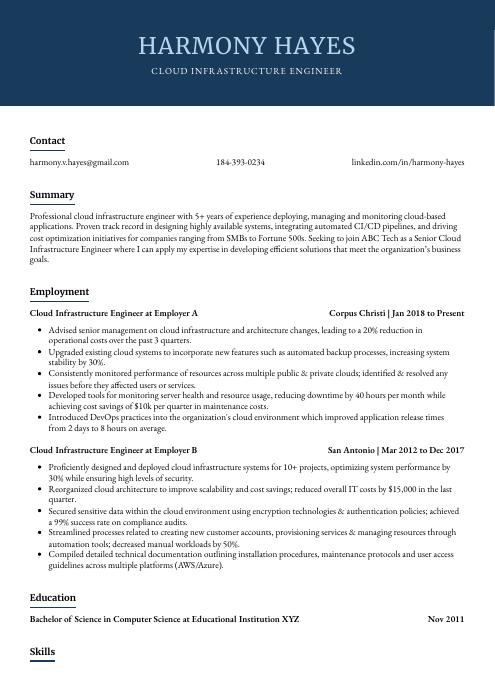 Bonobo
Bonobo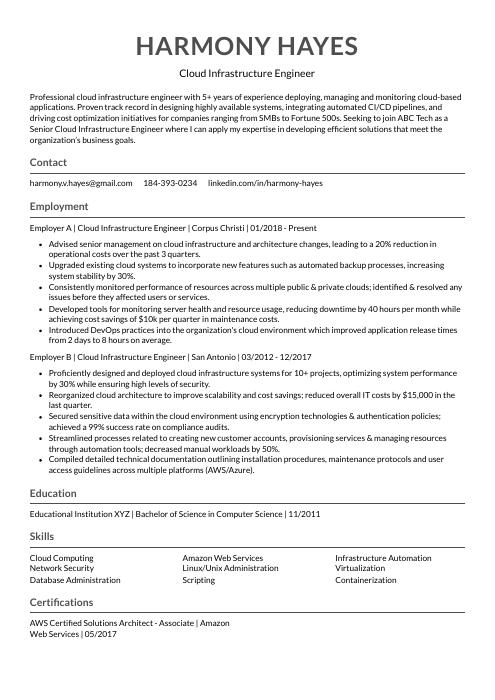 Indri
Indri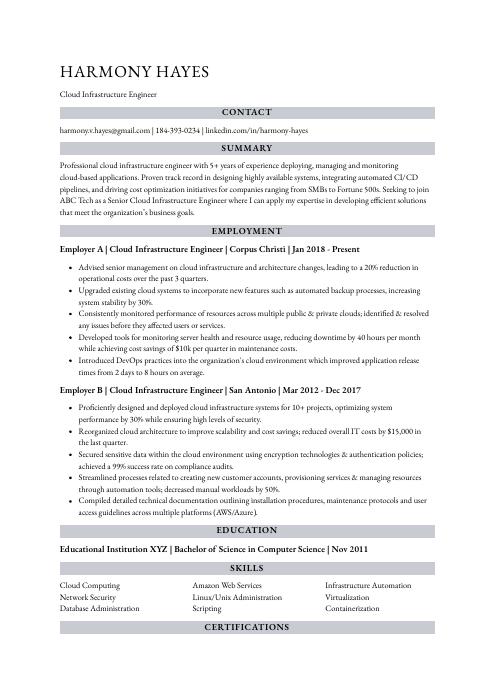 Numbat
Numbat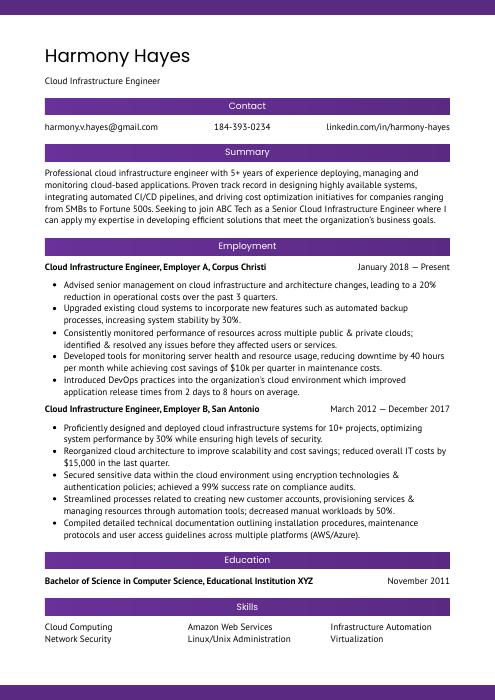 Jerboa
Jerboa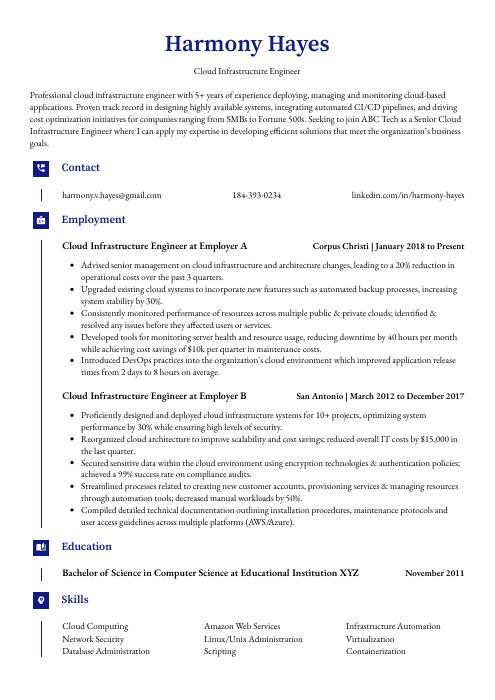 Gharial
Gharial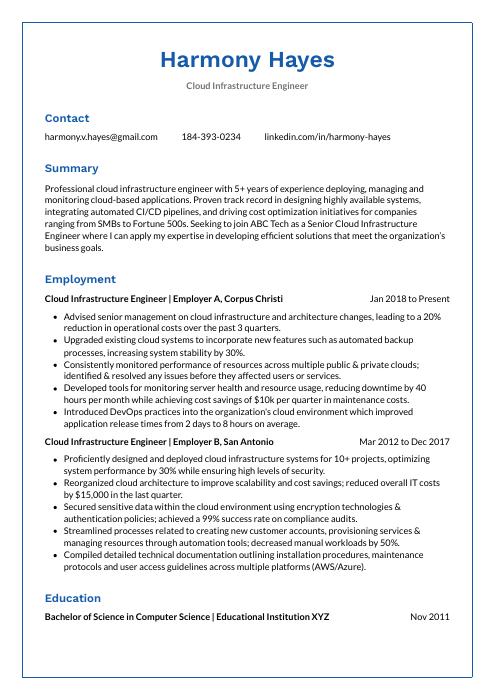 Markhor
Markhor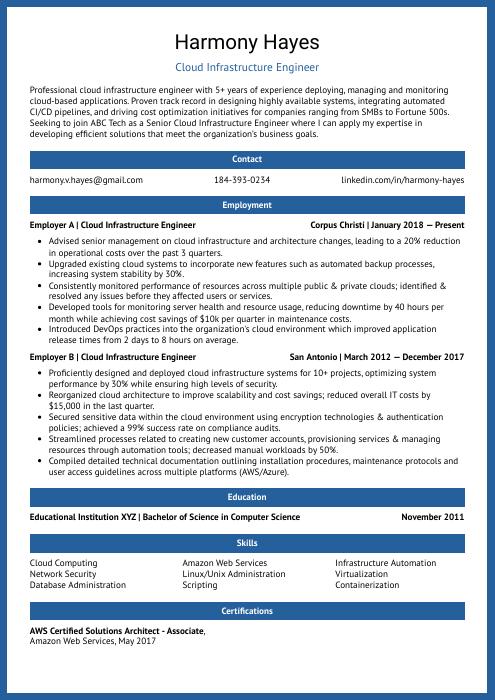 Ocelot
Ocelot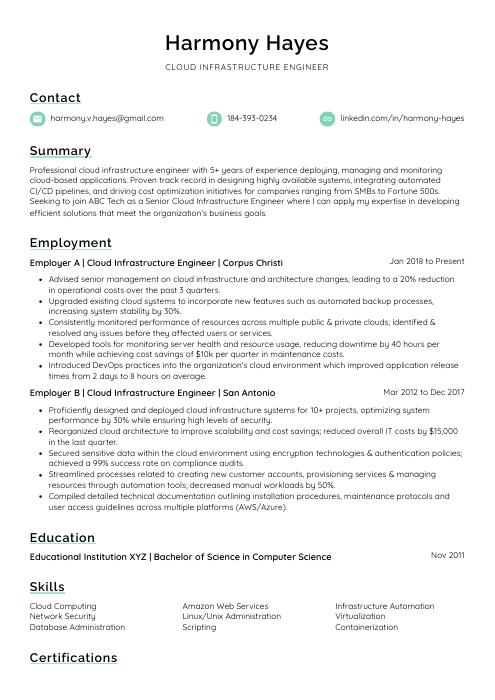 Lorikeet
Lorikeet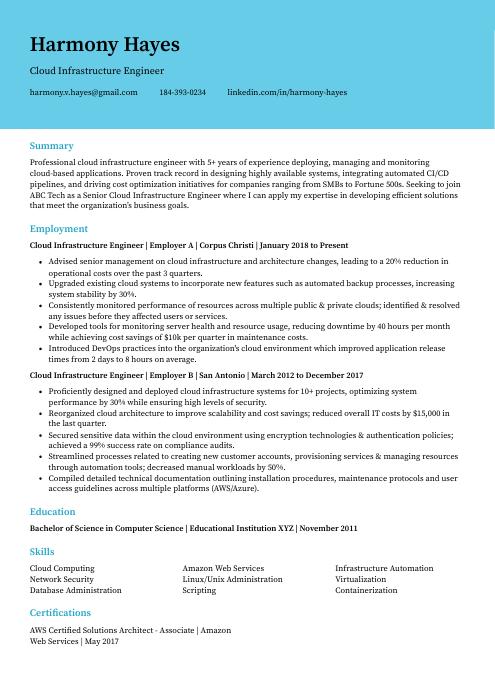 Dugong
Dugong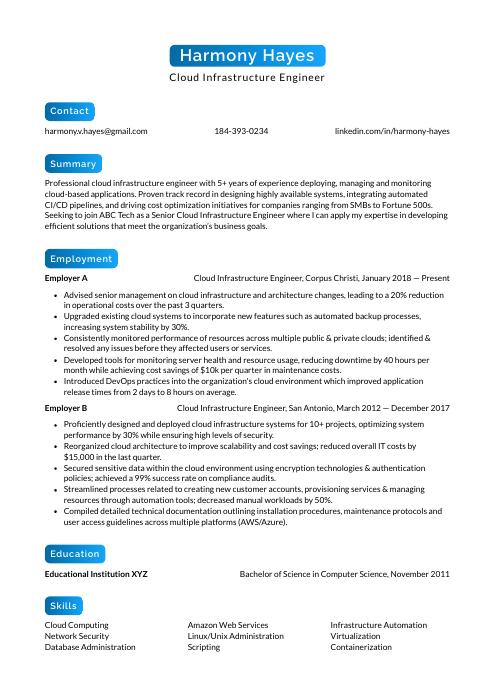 Kinkajou
Kinkajou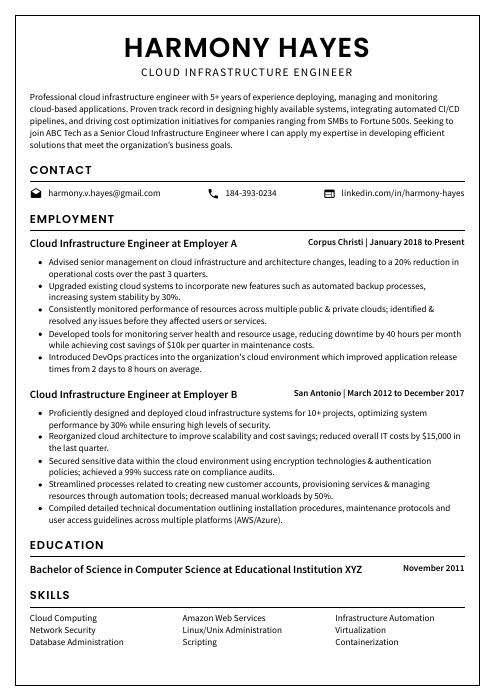 Cormorant
Cormorant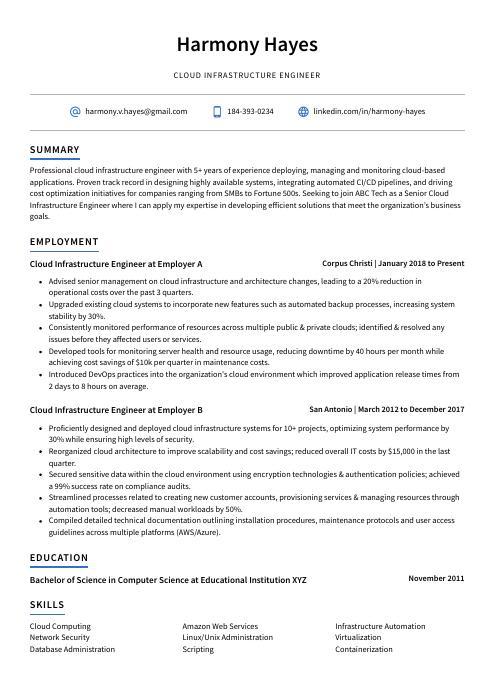 Axolotl
Axolotl Rezjumei
Rezjumei
